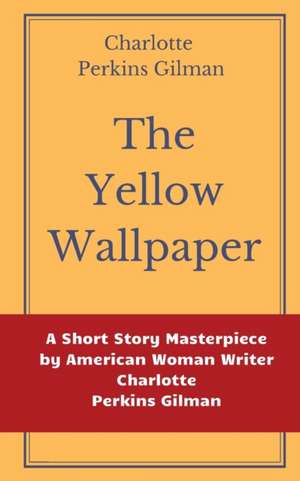The Yellow Wallpaper by Charlotte Perkins Gilman: A Short Story Masterpiece by American Woman Writer Charlotte Perkins Gilman
Autor Charlotte Perkins Gilmanen Limba Engleză Paperback – 21 iul 2020
Preț: 84.93 lei
Nou
Puncte Express: 127
Preț estimativ în valută:
16.26€ • 16.96$ • 13.63£
16.26€ • 16.96$ • 13.63£
Carte disponibilă
Livrare economică 19 februarie-05 martie
Preluare comenzi: 021 569.72.76
Specificații
ISBN-13: 9782491251314
ISBN-10: 2491251310
Pagini: 18
Dimensiuni: 127 x 203 x 1 mm
Greutate: 0.03 kg
Editura: Les Prairies Numeriques
ISBN-10: 2491251310
Pagini: 18
Dimensiuni: 127 x 203 x 1 mm
Greutate: 0.03 kg
Editura: Les Prairies Numeriques
Notă biografică
Who Was Charlotte Perkins Gilman? Charlotte Perkins Gilman was born on July 3, 1860, in Hartford, Connecticut. She published her best-known short story "The Yellow Wall-Paper" in 1892. One of her greatest works of non-fiction, Women and Economics, was published in 1898. Along with writing books, she established a magazine, The Forerunner, which was published from 1909 to 1916. Gilman committed suicide on August 17, 1935, in Pasadena, California. Early Life Gilman was born on July 3, 1860, in Hartford, Connecticut. Gilman was a writer and social activist during the late 1800s and early 1900s. She had a difficult childhood. Her father, Frederick Beecher Perkins was a relative of well-known and influential Beecher family, including the writer Harriet Beecher Stowe. But he abandoned the family, leaving Charlotte's mother to raise two children on her own. Gilman moved around a lot as a result and her education suffered greatly for it. Marriage and Inspiration Gilman married artist Charles Stetson in 1884. The couple had a daughter named Katherine. Sometime during her decade-long marriage to Stetson, Gilman experienced severe depression and underwent a series of unusual treatments for it. This experience is believed to have inspired her best-known short story "The Yellow Wall-Paper" (1892). Women's Rights Activism While she is best known for her fiction, Gilman was also a successful lecturer and intellectual. One of her greatest works of nonfiction, Women and Economics, was published in 1898. A feminist, she called for women to gain economic independence, and the work helped cement her standing as a social theorist. It was even used as a textbook at one time. Other important nonfiction works followed, such as The Home: Its Work and Influence (1903) and Does a Man Support His Wife? (1915). Along with writing books, Gilman established The Forerunner, a magazine that allowed her to express her ideas on women's issues and on social reform. It was published from 1909 to 1916 and included essays, opinion pieces, fiction, poetry and excerpts from novels. Death In 1900, Gilman had married for the second time. She wed her cousin George Gilman, and the two stayed together until his death in 1934. The next year she discovered that she had inoperable breast cancer. Gilman committed suicide on August 17, 1935.
